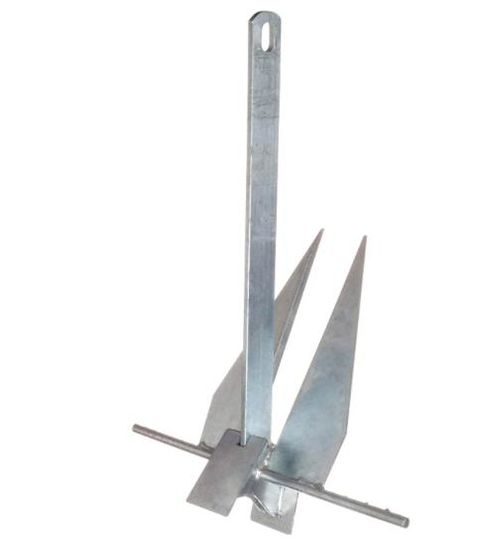Fluke Style Anchor for Dummies
Wiki Article
A Biased View of Fluke Style Anchor
Table of ContentsEverything about Fluke Style AnchorSome Known Incorrect Statements About Fluke Style Anchor 8 Easy Facts About Fluke Style Anchor Explained5 Simple Techniques For Fluke Style Anchor
Claw supports are less complicated to set, less most likely to foul, as well as easier to reset if they drag. However, they do not supply as much holding power as a fluke-style support. Plow-style anchors are one of the most usual kind of support used on little to medium-sized watercrafts. They are very easy to deploy and retrieve as well as give excellent holding power in many problems.They are a lot more efficient at establishing in soft bases, and also they have a greater holding power-to-weight ratio. Mushroom anchors are the largest and heaviest kind of anchor, and they are normally utilized on big boats or in deep water. They have the highest possible holding power of any type of type of anchor, yet they can be testing to release as well as retrieve.
It is designed to permeate the sea floor as well as supply a secure hold for your watercraft. Fluke supports are normally made from high-grade materials such as galvanized steel as well as are build to last. Fluke anchor dragging can be an irritating issue for seafarers. This sort of dragging takes place when the anchor line ends up being tangled around the anchor's flukes, stopping it from setting correctly.
This tool connects to the support line and also stops it from twisting. Another alternative is to make use of a longer support line. This will give the support extra room to set effectively as well as will certainly decrease the possibilities of the line ending up being twisted. Examine the rode to ensure it is not fouled or tangled.
The Best Strategy To Use For Fluke Style Anchor
Check the support itself to see if it is harmed or if the flukes are not dug in correctly. If so, try resetting the anchor. If all else falls short, you can try relocating the watercraft to a different place.This layout allows for an appropriate setting no matter the angle the anchor lands. When picking your next anchor visit us below at Wholesale Marine.
By Tom Burden, Last updated: 5/28/2020 Anchor rodes contain a size of chain, rope or a mix of rope and also chain that attaches an anchor to a watercraft. The rope section of support rodes normally contains nylon three-strand, 12-strand or double-braid line. Nylon is the product of option, because it is elastic and able to take in the shock lots encountered when anchoring - Fluke Style Anchor.
Numerous little boats use Go Here anchor rodes made totally of three-strand nylon line. This is due to the fact that all-rope rodes are light-weight, low-cost as well as simpler to store than rope-chain or all-chain rodes. All-rope rodes can be fairly strong, they lack the chafe resistance of chain and are therefore not ideal for anchoring near reefs, amongst rocks or in anchorages with great deals of rise as well as wave recommended you read action.
Some Known Incorrect Statements About Fluke Style Anchor

This lowers the requirement for lengthy extent (other than in shallow water) since the chain is heavy and pushes the base till extreme problems are encountered, when more scope might be called for. Since chain has very little flexibility, treatment ought to be taken to prevent the chain from becoming "bar tight" in high winds by using a snubber made from nylon line.
It is reasonably light (just 65 pound.) and significantly solid. Grade 43, called G4 or HT; made from high-carbon steel. G4 is the favored chain for securing or windlass applications, and has two times the working lots of BBB chain, so you can utilize a smaller sized size with the exact same toughness.
BBB or "Three-way B" has an uniform pitch short web link, and works well on windlass gypsies. BBB utilized to be one of the most popular kind for windlass styles of the past, yet has actually been changed by G4. Proof Coil does not have a consistent pitch and does not collaborate with anchor windlasses.
Fluke Style Anchor Things To Know Before You Get This
Little galvanized shackles link the anchor to the length of chain, and also connect the chain to the thimble on the anchor line. Fluke Style Anchor. Keep in mind to make use of the "following evaluate" in shackles; a length of 1/4" chain would certainly be matched to a 5/16" go now shackle. This system, with a long size of three-strand nylon line, a moderate size of chain and a properly sized support will certainly please the needs of the bulk of seafarers, with boats as much as the 30' dimension array.
High-strength chain like these enables you to drop a dimension which minimizes the chain's weight by concerning 30%, while attaining the exact same working lots capability and also utmost toughness. Matching anchor chain to a specific vessel can be difficult, since the windage of the vessel is probably the vital selection aspect, and windage is difficult to establish.
Report this wiki page